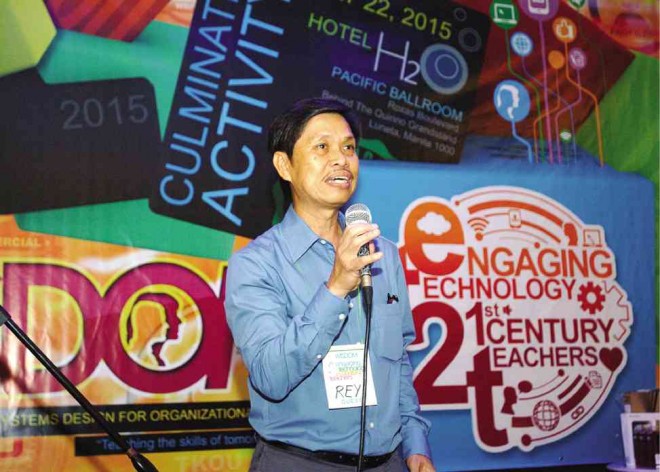The cell phone is a tool, not an enemy. This was one of the first things over 200 teachers from some 40 schools learned at TechnoKids Philippines’ annual Workshop on Instructional Systems Design for Organizational Masters, or Wisdom.
In his presentation, Stephen Jay Co, head of undergraduate studies of Far Eastern University’s Institute of Education, challenged his fellow educators to adjust their teaching styles to the technologies around them, including cell phones and the Web, if they were to be 21st-century teachers.
“Be different, learn different,” Co said as he enjoined teachers to think of gadgets as tools to make the classroom experience more engaging.
Online sources could help students further their knowledge or identify gaps and ask better questions, he said.
Teachers could also evaluate their students’ learning through podcasts (episodic series of audio content), movies, songs and other outputs, using their laptops.
Co also discussed the emerging trend of flipped classrooms that allowed students to access a teacher’s lectures in advance, through the Internet and other means.
In the current setup, students are encouraged to study ahead, pick up ideas in class and do their homework.
With the flipped classrooms, time spent in school will become a period for interaction, application and deeper understanding.
Another speaker, John Gary Garcia, a Google-certified teacher from Saint Poveda College, said conditions were ripe for technological integration.
He presented the results of his small-scale study that covered 383 students in Grade 10 and third and fourth year high school. Of the students surveyed, only one had no Internet access at home and only 15 owned phones that could not connect to the Web.
A pie graph showed all but one of Garcia’s respondents had e-mail addresses, most even had two or more. For all the respondents, he said, the Internet provided more than just access to social networks. It was also used for tasks like research, reading and downloading content.
VIENNA Austria (above), assistant curriculum manager of TechnoKids Philippines, awards a plaque of recognition to John Gary Garcia of Poveda
“There is a change in the nature of learners,” Garcia said. Today’s students, he said, required teachers to challenge the methods they used to teach. “I cannot teach the way I was taught,” he said.
He also said today’s students could multitask while learning. They could listen to music while reading a book, for instance.
Students also wanted their opinions recognized and they demanded innovative lectures and teaching materials.
Garcia said today’s students needed to be taught how to use these skills as tools.
But he stressed, “Technology will not replace human imagination, especially for teachers willing to share their expertise with their students.”
Garcia said, “We have to teach our students to be critical thinkers … these are the students we have to produce.” Emerging technologies, he said, fostered deeper thinking.
He displayed some of his students’ works, as he encouraged teachers to use websites like YouTube or services like Google Hangouts for video conferences and Google Forms for examinations.
All these developments, Garcia said, could enrich the learning experience and the assessment process. “Everything can be done online,” he told the audience.
Co encouraged the teachers to “use the Web, social media, tablets and apps.”
Since digital migrants (teachers) are teaching digital natives, he advised them, “Be as tech-savvy (as your students).”
Co said, “If we keep on practicing those (new) skills, we become better teachers, we make our lesson meaningful and we prepare our students for life.”
Vienna Austria, assistant curriculum manager of TechnoKids Philippines, said what made a 21st century teacher was “first and foremost, the ability to adjust to the change.”
PARTICIPANTS of Wisdom 2015 hurdle the PhotoShop challenge, where they have to edit a photo to match a sample given to them. Photos by RODEL ROTONI
She said, “There are so many changes happening, in the students, the education system and the technologies.”
Computer teacher Jennifer Abejero of Cainta Catholic College, who has been attending Wisdom since it began in 2009, agreed: “The technologies we can use keep changing every year. Never have things changed this fast. You have to update yourself every time.”
TechnoKids Philippines, founded in Canada and launched in the country in 2002, provides up-to-date computer curriculum, said Austria.
By hosting training activities like Wisdom and TechnoKids Open University, flipped classroom experience for teachers, it kept its client-schools abreast of new developments, she said.
She said this year’s workshop participation exceeded expectations.
“TechnoKids keeps us in the loop,” said Abejero. She said she was glad Reynaldo S. Dantes of the Technical Education and Skills Development Authority and Christine Magboo of the Department of Education explained that computer teachers would have a role in the K-12 (kindergarten to Grade 12) basic education program.
Abejero said she liked the raffles and creative games that revolved around computer codes, editing skills and robotics, among others, as they made her feel appreciated.
